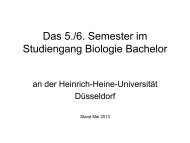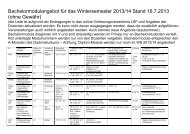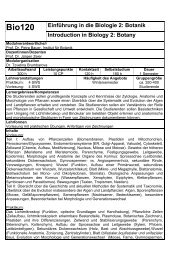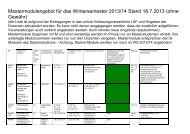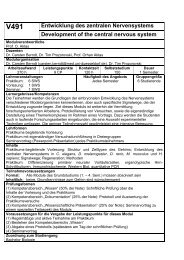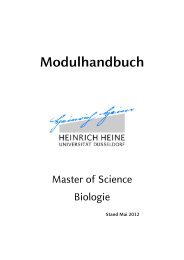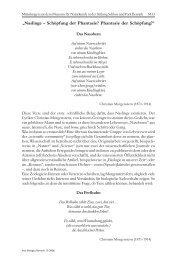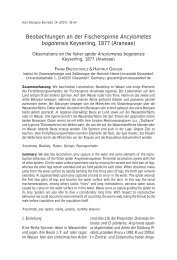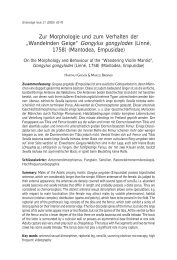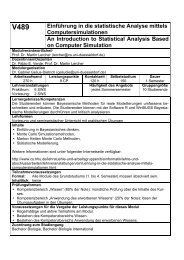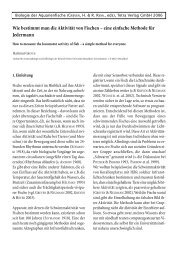Contents_60_01_2010 _ final.indd - Biologie - Heinrich-Heine ...
Contents_60_01_2010 _ final.indd - Biologie - Heinrich-Heine ...
Contents_60_01_2010 _ final.indd - Biologie - Heinrich-Heine ...
Create successful ePaper yourself
Turn your PDF publications into a flip-book with our unique Google optimized e-Paper software.
Vertebrate Zoology<br />
<strong>60</strong> (1) 2<strong>01</strong>0<br />
27 – 35<br />
27<br />
© Museum für Tierkunde Dresden, ISSN 1864-5755, 18.05.2<strong>01</strong>0<br />
A microscopic and microanalytical study (Fe, Ca)<br />
of the teeth of the larval and juvenile Ambystoma mexicanum<br />
(Amphibia: Urodela: Ambystomatidae)*<br />
> Abstract<br />
* Dedicated to Prof. Dr. H. Hartwig, Cologne (Germany)<br />
on the occasion of his 100th birthday<br />
HEIKO RICHTER 1 , HORST KIERDORF 1 , UWE KIERDORF 1 , GÜNTER CLEMEN 2 &<br />
3 **<br />
HARTMUT GREVEN<br />
1 Abteilung <strong>Biologie</strong> der Universität Hildesheim, Marienburger Platz 22, D-31141 Hildesheim; Germany<br />
kierdorf(at)uni-hildesheim.de<br />
2 Doornbeckeweg 17, D-48161 Münster, Germany<br />
gclemen(at)web.de<br />
3 Institut für Zoomorphologie und Zellbiologie der <strong>Heinrich</strong>-<strong>Heine</strong>-Universität Düsseldorf<br />
Universitätsstr.1, D-40225 Düsseldorf, Germany<br />
grevenh(at)uni-duesseldorf.de<br />
** Corresponding author<br />
Received on March 3, 2<strong>01</strong>0, accepted on April 15, 2<strong>01</strong>0.<br />
Published online at www.vertebrate-zoology.de on May 12, 2<strong>01</strong>0.<br />
We studied the teeth of larvae and one juvenile of the axolotl Ambystoma mexicanum, a urodele species that undergoes partial<br />
metamorphosis, by light microscopy of ground sections, backscattered electron imaging and semi-quantitative microanalysis<br />
in the scanning electron microscope. By applying these techniques it was possible to identify enamel, enameloid and<br />
dentin in the teeth. Iron was found to be present in enamel and enameloid, the concentrations being highest in the enamel.<br />
A staining indicative of the presence of iron was observed in the inner dental epithelium of tooth germs. Dentinal tubules<br />
mostly followed a straight course, but some recurved over a short distance distally. In larval teeth and teeth of “larval type” in<br />
the juvenile individual the dentinal tubules ended in the basal portion of the enameloid. Our results show that in the axolotl,<br />
monocuspid teeth of the “larval type” that developed after partial transformation still possess an enameloid layer beneath a<br />
thin enamel cap. The fi ndings of the present study are consistent with the view that enameloid matrix is secreted by odontoblasts,<br />
while enameloid maturation is (largely) controlled by ameloblasts.<br />
> Zusammenfassung<br />
Die Zähne von Larven und einem juvenilen Exemplar von Ambystoma mexicanum, einer Urodelenart, die eine partielle Metamorphose<br />
durchläuft, wurden mittels Lichtmikrokopie von Dünnschliffen sowie Rückstreuelektronen-Aufnahmen und semiquantitativer<br />
Mikroanalyse im Rasterelektronenmikroskop untersucht. Diese Methoden erlaubten die Identifi zierung von<br />
Dentin, Enameloid und Schmelz in den Zähnen. Eisen wurde im Schmelz und im Enameloid nachgewiesen, mit höchsten<br />
Konzentrationen im Schmelz. Eine auf das Vorhandensein von Eisen hindeutende Verfärbung fand sich im inneren Schmelzepithel<br />
von Zahnkeimen. Die Dentinkanälchen verliefen zumeist gerade, waren jedoch in einigen Fällen distal umgebogen.<br />
In Larvenzähnen und Zähnen des „larvalen Typus“ des juvenilen Individuums endeten die Dentinkanälchen im basalen<br />
Bereich des Enameloids. Unsere Ergebnisse zeigen, dass beim transformierten Axolotl monocuspide Zähne des „larvalen<br />
Typs“ weiterhin eine Enameloid-Zone unterhalb einer dünnen Schmelzkappe besitzen. Die Ergebnisse der vorliegenden<br />
Untersuchung stehen im Einklang mit der Auffassung, dass die Enameloid-Matrix ein Sekretionsprodukt der Odontoblasten<br />
ist, während die Reifung des Enameloids (überwiegend) unter Kontrolle der Ameloblasten erfolgt.<br />
> Key words<br />
Dentition, axolotl, SEM-BSE imaging, EDX-microanalysis, iron, dentin, enamel, enameloid.
28<br />
Introduction<br />
The dentition of Urodela (= Caudata) undergoes remarkable<br />
changes during ontogeny. Typically, teeth<br />
of young larvae are monocuspid and non-pedicellate<br />
(“early larval type”). Teeth formed later during the<br />
larval period are divided by a more or less distinct annular<br />
zone of weakness (“late larval type”) located in<br />
the crown and the pedicel (“pedicellate condition”).<br />
Teeth formed by metamorphosing and post-metamorphic<br />
individuals on the remaining or the newly formed<br />
dentigerous bones are bicuspid in most species and<br />
fully pedicellate, i.e., these teeth show a distinct asymmetrical<br />
zone of division (SMITH & MILES 1971, GRE-<br />
VEN 1989, CLEMEN & GREVEN 1994, DAVIT-BÉAL et al.<br />
2006, 2007a, b).<br />
A urodele tooth is formed by cells of the (ectomesenchymal)<br />
dental papilla and the (ectodermal)<br />
enamel organ. Mesenchymal cells of the papilla<br />
(o don toblasts) produce dentin, whereas the polarized<br />
cells of the inner dental epithelium (ameloblasts) produce<br />
enamel. In larval teeth, an extremely thin layer<br />
of enamel is underlain by a densely mineralised modifi<br />
ed dentin that is referred to as enameloid (SMITH &<br />
MILES 1971). Enameloid is a product of joint odontoblast<br />
and ameloblast activities. According to recent<br />
studies, enameloid matrix is secreted by odontoblasts,<br />
while enameloid maturation is controlled by ameloblasts<br />
(DAVIT-BÉAL et al. 2007a, b). In contrast to dentin,<br />
mature enameloid possesses only few collagen<br />
fi bres (SCHMIDT 1957; ROUX & CHIBON 1973; SMITH<br />
& MILES 1971; BOLTE & CLEMEN 1992; KOGAYA et al.<br />
1992; KOGAYA 1994, 1999; WISTUBA et al. 2002, DA-<br />
VIT-BÉAL et al. 2007a, b).<br />
The contents of calcium and phosphorus, constituting<br />
major components of the hydroxyapatite that<br />
forms the mineral phase of dental hard tissues, have<br />
been studied in functional teeth of post-metamorphic<br />
individuals of several urodele species (Salamandra<br />
salamandra: CLEMEN et al. 1980; Dicamptodon ensatus,<br />
Onychodactylus japonicus: SATO et al. 1991, 1992,<br />
Ambystoma maculatum, Salamandra salamandra,<br />
Ane ides lugubris: SATO et al. 1993) as well as in individuals<br />
of paedomorphic species (Ambystoma mexicanum:<br />
CHIBON & ELOY 1979, BOLTE et al. 1996; Cryptobranchus<br />
alleganiensis, Amphiuma means, Necturus<br />
maculosus, Andrias davidianus: SATO et al. 1991,<br />
1992; Megalobatrachus (now Andrias) japonicus:<br />
SHIMADA et al. 1993). To our knowledge, only SATO et<br />
al. (1991, 1992) and SHIMADA et al. (1993) have analysed<br />
urodele teeth for trace elements such as fl uorine,<br />
magnesium and iron.<br />
Similar to several other paedomorphic species<br />
(e.g., Amphiuma means: CLEMEN & GREVEN 1980; An-<br />
RICHTER et al.: Microscopy and microanalysis of axolotl teeth<br />
drias spp.: GREVEN & CLEMEN 1980; Cryptobranchus<br />
alleganiensis: GREVEN & CLEMEN 2009), the dentition<br />
of the axolotl Ambystoma mexicanum undergoes a<br />
partial metamorphosis. Juvenile and adult specimens<br />
possess a single row of bicuspid fully pedicellate teeth<br />
in the upper jaw, a single row of weakly pedicellate<br />
monocuspid teeth on the vomeropalatinum (for terminology<br />
see CLEMEN 1979) and the coronoids, and a<br />
mosaic of mono- and bicuspids on the dentaries (KERR<br />
19<strong>60</strong>; CLEMEN & GREVEN 1977; BOLTE & CLEMEN<br />
1991). Thus, the axolotl offers the opportunity to compare<br />
teeth exhibiting the morphological characteristics<br />
of larval and transformed stages in a single individual.<br />
However, teeth of larval appearance present in partially<br />
metamorphosed individuals may differ in some<br />
aspects, e.g. size and shape, type of ankylosis, amount<br />
of enameloid, from “true” larval teeth, because the<br />
former teeth represent a more advanced developmental<br />
stage (CLEMEN et al. 2009).<br />
The present paper describes true larval teeth as<br />
well as teeth of larval appearance and bicuspid teeth<br />
of a transformed individual of the axolotl, using light<br />
microscopy of ground sections, backscattered electron<br />
(BSE)-imaging in the scanning electron microscope<br />
and energy dispersive X-ray analysis of calcium and<br />
iron.<br />
Materials and methods<br />
Animals<br />
A juvenile axolotl (length of about 14 cm) and three<br />
larvae measuring, respectively, 5.5, 6.5, and 7 cm<br />
were obtained from a private breeder. Specimens were<br />
killed with an overdose of MS 222 (Sandoz) and de-<br />
Fig. 1 a – i. Unstained ground sections of teeth of a juvenile<br />
axolotl (a–f) and of larvae of different lengths (g–i). Note the<br />
brownish apices in all teeth (transmitted light, phase contrast).<br />
a: Bicuspid pedicellate premaxillary tooth and tooth bud (arrow).<br />
Zone of division (arrowhead), crown (cr), pedicel (pd),<br />
pre maxilla (pm). b: Tooth bud, detail of (a); note numerous<br />
dentinal tubules (arrow), stained enamel layer (arrowhead), and<br />
staining of the inner dental epithelium (asterisk). c: Established<br />
monocuspid coronoid tooth with a rudimentary zone of division<br />
(arrow), and a tooth bud (left side of image); note faint staining in<br />
the enamel organ of the tooth bud (arrowheads). d: Monocuspid<br />
apex of an established coronoid tooth with numerous dentinal<br />
tubules (arrow). e: Tooth bud, dentary; note staining of the<br />
enamel organ (arrowhead). f: Monocuspid vomerine tooth with<br />
enameloid (arrow). g: Premaxilllary tooth with enameloid (arrowhead).<br />
h: Vomerine tooth; note the enameloid (arrowhead)<br />
and the dentinal tubules (arrows). i: Tooth bud from coronoid;<br />
note staining of the inner dental epithelium (asterisk).
■ Vertebrate Zoology <strong>60</strong> (1) 2<strong>01</strong>0<br />
29
30<br />
capitated. Premaxillae, dentaries and vomeres were excised<br />
and fi xed in 4% neutral buffered formalin for 48<br />
h, and dehydrated in increasing concentrations of ethanol<br />
and fi nally acetone. For embedding, the samples<br />
were transferred into dichloromethane. Subsequently<br />
they were embedded in epoxy resin (Biodur E12 with<br />
hardener E1, Biodur Products, Heidelberg, Germany),<br />
evacuated and cured for at least 7d at 30° C. The resulting<br />
blocks were sectioned parallel to the long axes of<br />
the teeth in a bucco-lingual (vomeres) or mesio-distal<br />
plane (premaxilllae, dentaries), using a rotary saw with<br />
a water-cooled diamond blade (Woco 50, Conrad Apparatebau,<br />
Clausthal-Zellerfeld, Germany). One of the<br />
two resulting blocks was used for light microscopy, the<br />
other for BSE-imaging and microanalysis.<br />
Light microscopy<br />
Blocks were ground (silicon carbide paper, grit 1200)<br />
until a tooth was exposed at the surface. Under microscopic<br />
control it was attempted to produce a longitudinal<br />
section running through the tip of the tooth apex<br />
(sensu SMITH & MILES 1971). The block surface was<br />
polished using a series of silicon carbide papers (grits<br />
2400 and 4000) and a section of 2 mm thickness was<br />
cut from the block. The polished surface was mounted<br />
on a glass slide with Biodur embedding medium. The<br />
block was then reduced to a thickness of about 200μm<br />
using a face wheel, ground and polished to a fi nal<br />
thickness of 70μm with the graded silicon carbide papers,<br />
and cover slipped. Ground sections were viewed<br />
in transmitted light with phase contrast and photographed,<br />
using an Axioskop 2 Plus microscope (Zeiss,<br />
Jena, Germany) equipped with a Canon PowerShot G2<br />
digital camera (Canon, Tokyo, Japan). The acquired<br />
images were further processed with the software package<br />
Photoshop 7.0 (Adobe, San Jose, CA, USA).<br />
Backscattered electron imaging and<br />
microanalysis<br />
For BSE-imaging in the scanning electron microscope<br />
(SEM), the cut surface of the other block was ground<br />
with silicon carbide paper (grit 1200) until a tooth was<br />
exposed at the surface. Again care was taken to obtain<br />
a longitudinal section through the tip of the tooth apex<br />
The block surface was then polished on a motorized<br />
rotor polisher (Labopol-5, Struers, Copenhagen, Denmark)<br />
using diamond suspensions (Diapro, Struers)<br />
with, respectively, 9 μm and 3 μm particle diameters<br />
and a fi nal polishing step (OP-S Colloidal Silica Suspension,<br />
Struers). BSE imaging of the polished surfaces<br />
was performed with an FEI Quanta <strong>60</strong>0 FEG SEM<br />
(Hilsboro, USA) equipped with a solid-state backscat-<br />
RICHTER et al.: Microscopy and microanalysis of axolotl teeth<br />
tered electron detector. The SEM was operated in a<br />
low-vacuum mode at an accelerating voltage of 20 kV.<br />
Semi-quantitative analysis of calcium and iron contents<br />
in the teeth was performed with an EDX-microanalysis-detector<br />
integrated in the SEM. Line scans of<br />
between 40 and <strong>60</strong> μm length were run from the dentin<br />
to the enamel of the tooth tip. The data generated with<br />
this method should be considered as semi-quantitative.<br />
Results<br />
Light microscopy and SEM findings<br />
In the ¥ground sections, a yellowish to brownish staining<br />
was observed in the tooth apices. This staining was<br />
most intense in the enamel cap at the tip of the tooth<br />
crown and faded in proximal direction (Fig. 1). The<br />
dentin shaft and the pedicel were unstained (Fig. 1);<br />
however, the enamel organ of tooth buds, especially<br />
the inner dental epithelium, also showed some staining<br />
(Fig. 1b, c, e, i).<br />
The largest specimen available for study was a<br />
juvenile individual, possessing bicuspid pedicellate<br />
teeth in the upper jaw (Fig. 1a), monocuspid teeth on<br />
the coronoid (Fig. 1c, d) monocuspid (Fig. 1e) and bicuspid<br />
teeth on the dentaries, and monocuspid teeth<br />
on the vomer (Fig. 1f). The dentin exhibited numerous<br />
dentinal tubules that in the bicuspid teeth terminated<br />
immediately beneath the enamel layer (Fig. 1b, Fig.<br />
2a, b).<br />
All teeth of the three larvae were monocuspid (Fig.<br />
1g – i) and exhibited only traces of a dividing zone.<br />
Dentinal tubules terminated at a certain distance from<br />
the enamel cap, with some of the tubules appearing to<br />
Fig. 2 a – f. SEM-BSE images of teeth of a juvenile axolotl (ac)<br />
and of larvae of different lengths (d-f). The courses of the<br />
EDX line scans (Fig. 3) are indicated. a: Bicuspid premaxillary<br />
tooth with the lingual cusp on the left side; note presence of<br />
numerous dentinal tubules. b: Detail of (a), labial cusp; note<br />
the division of the enamel layer into two sublayers (1, 2) of<br />
different brightness (mineral density) and the recurved dentinal<br />
tubules (arrowheads) beneath the enamel cap. c: Monocuspid<br />
vomerine tooth; note thin enamel layer (arrowheads) and the<br />
enameloid (en). Dentinal tubules can be seen to reach into the<br />
basal portion of the enameloid. d: Monocuspid dentary tooth<br />
(7 cm larva), the approximate position of the enameloid-dentin<br />
junction is indicated by an asterisk. e: Monocuspid, tangentially<br />
sectioned vomerine tooth (6.5 cm larva); note numerous,<br />
partly recurved dentinal tubules (arrowhead) and thin enamel<br />
cap (asterisk). f: Monocuspid vomerine tooth (5.5 cm larva);<br />
note cloudy pattern of mineralization in juxtapulpal dentin (arrows)<br />
and openings of dentinal tubules at the dentin-pulp interface<br />
(arrowheads).
■ Vertebrate Zoology <strong>60</strong> (1) 2<strong>01</strong>0<br />
31
32<br />
follow a recurved course distally (Fig. 1h, Fig. 2d – f).<br />
SEM-BSE images of the polished cut surfaces of the<br />
teeth showed a variation in brightness of the dental<br />
hard tissues, ranging from the bright (highly mineralized)<br />
enamel layer to the grey of the less mineralized<br />
dentin (Fig. 2). In the bicuspid teeth, two enamel<br />
portions could be distinguished by their brightness.<br />
A thin outermost rim of highly mineralized enamel<br />
(appearing very bright on SEM-BSE images), overlaid<br />
a slightly less bright (= less mineralized) inner enamel<br />
layer (Fig. 2b). The entire enamel layer was clearly<br />
delimited from the underlying dentin.<br />
In the bicuspid teeth, the maximum thickness of the<br />
enamel layer (at the cusp tips) was between 9 and 10<br />
μm. Between the tips, enamel thickness was slightly<br />
less, further decreasing towards the pedicel. The monocuspid<br />
teeth of the juvenile individual showed thin,<br />
bright enamel caps that measured approximately 3 μm<br />
in thickness (Fig. 2c). In these teeth, a layer of enameloid<br />
was intercalated between the enamel cap and the<br />
dentin. SEM-BSE imaging revealed that the degree<br />
of mineralization of the enameloid was intermediate<br />
between enamel and dentin, gradually increasing<br />
towards the enamel (Fig. 2c). Dentinal tubules were<br />
present in the basal portion of the enameloid, but did<br />
not reach up to the enamel-enameloid junction (Fig.<br />
1d, h). The junction between enameloid and dentin<br />
was indistinct (Fig. 1d, f, 2c).<br />
The teeth of the larvae resembled the monocuspid<br />
teeth of the juvenile individual insofar as they also<br />
possessed a very thin enamel cap and an enameloid<br />
layer interposed between enamel and dentin (Fig. 2d).<br />
In both ground sections and SEM-BSE images, the<br />
junction between enameloid and underlying dentin<br />
was indistinct (Fig. 1h, 2d). At the dentin-pulp interface,<br />
openings of dentinal tubules were visible, and the<br />
juxtapulpal dentin was characterized by a cloudy pattern<br />
of mineralization (Fig. 2f).<br />
Microanalysis<br />
Line scans through bicuspid teeth revealed the presence<br />
of iron in the enamel, with concentrations increasing<br />
towards the tip of the enamel cap (Fig. 3a,<br />
b). The low Fe-counts in the dentin are regarded to<br />
represent a non-specifi c background. In the monocuspid<br />
teeth of the juvenile individual (Fig. 3c) and one<br />
of the larvae (Fig. 3d), iron was observed to be present<br />
in both enameloid and enamel. Fe-concentrations progressively<br />
increased throughout the enameloid layer<br />
towards the enamel and further in the enamel cap towards<br />
the tip of the tooth apex.<br />
In all analyzed teeth, calcium concentration in<br />
enamel and enameloid tended to be inversely related<br />
to that of iron (Fig. 3a – d).<br />
RICHTER et al.: Microscopy and microanalysis of axolotl teeth<br />
Discussion<br />
SEM-BSE images are a quick means of determining<br />
the relative degree of mineralization of dental hard tissues.<br />
The brighter a tissue appears, the more highly<br />
mineralized it is. Presence of an enamel cap covering<br />
the tooth apex was demonstrated in all studied teeth,<br />
the enamel being discernable as a bright layer of variable<br />
thickness. Enamel thickness was highest at the<br />
cusp tips and gradually decreased towards the pedicel.<br />
The bicuspid teeth of the transformed individual<br />
possessed the thickest enamel, while the enamel was<br />
thinnest in true larval teeth. In the bicuspid teeth, an<br />
inner and an outer enamel layer could be distinguished<br />
on SEM-BSE images. It is assumed that this subdivision<br />
corresponds to the fi ndings in other urodele species,<br />
in which an inner and an outer enamel layer were<br />
distinguished that differed in crystal arrangement and<br />
element distribution (SATO et al. 1991, 1992, 1993).<br />
In the present study, presence of enameloid was<br />
observed in true larval teeth. The tissue was identifi<br />
ed by its location, its higher mineral content (greater<br />
brightness in SEM-BSE images) compared to dentin,<br />
and the lack of dentinal tubules in its more apical<br />
portions. Using the above criteria it is concluded that<br />
enameloid is also present in the monocuspid teeth of<br />
the juvenile, which have retained their larval appearance,<br />
but is obviously absent from the bicuspid teeth<br />
of the same individual.<br />
There is consensus that the teeth of larval urodeles<br />
possess a cap of dentin-like enameloid covered by<br />
a very thin layer of enamel (ROUX & CHIBON 1973;<br />
BOLTE & CLEMEN 1992; BOLTE et al. 1996; KOGAYA<br />
1994, 1999; WISTUBA et al. 2002; DAVIT-BÉAL et al.<br />
2007a, b). The present study demonstrated that the<br />
same is also the case for the “larval-type” teeth of the<br />
partially metamorphosed axolotl. The microscopic<br />
and microanalytical fi ndings of the present study are<br />
in accordance with the view that enameloid matrix is<br />
secreted by odontoblasts, while enameloid maturation<br />
is (largely) controlled by ameloblasts (DAVIT-BÉAL et<br />
al. 2007a, b).<br />
In accordance with the fi ndings of the present study,<br />
also transmission electron microscopic (TEM) studies<br />
on teeth of A. mexicanum (WISTUBA et al. 2002) and<br />
A. maculatum (SATO et al. 1993) suggest absence of<br />
enameloid in bicuspid axolotl teeth. In contrast, KA-<br />
WASAKI & FEARNHEAD (1983) described a highly mineralized<br />
tissue containing collagen beneath the enamel<br />
layer of teeth in adult Hynobius nigrescens and Cynops<br />
pyrrhogaster, for which they used the term enameloid.<br />
Results of TEM-studies and microprobe analysis indicated<br />
the presence of true enamel in the teeth of<br />
different adult paedomorphic and metamorphosing
■ Vertebrate Zoology <strong>60</strong> (1) 2<strong>01</strong>0<br />
Fig. 3 a – d. EDX line scans of calcium and iron in axolotl teeth. a, b: Scans through lingual (a, cf. Fig. 2a) and labial (b, cf. Fig.<br />
2b) cusps of a bicuspid premaxillary tooth of the juvenile individual. c: Scan through a monocuspid vomerine tooth of the juvenile<br />
individual (cf. Fig. 2c). d: Scan through a monocuspid dentary tooth of a larva of 7 cm length (cf. Fig. 2d).<br />
urodeles (SATO et al. 1991, 1992, 1993). The authors<br />
distinguished an outer from an inner layer covering<br />
the tooth apex, which differed in the concentration of<br />
certain elements. In neither of these two layers collagen<br />
was detected, thereby confi rming their nature as<br />
enamel. This condition has so far been demonstrated<br />
in fully transformed species (Dicamptodon ensatus,<br />
Onychodactylus fi scheri, Salamandra salamandra,<br />
Aneides lugubris, Ambystoma maculatum), in partially<br />
transformed species with bicuspid or otherwise modifi<br />
ed teeth (Amphiuma means: CLEMEN & GREVEN 1980,<br />
Andrias spp.: GREVEN & CLEMEN 1980; SHIMADA et al.<br />
1993), and in the monocuspid teeth of the “late larval<br />
stage” of adult paedomorphic Necturus maculosus<br />
(GREVEN & CLEMEN 1979).<br />
However, collagen was found to be present in the<br />
inner portion of the covering layer of the tooth apex<br />
in the paedomorphic Cryptobranchus alleganiensis,<br />
a species with a very early occurrence of teeth of<br />
the transformed type during ontogenesis (GREVEN<br />
& CLEMEN 2009) and in the caecilian Dermophis sp.<br />
(SATO et al. 1992). SATO et al (1992) concluded that<br />
the inner part of the covering layer of the tooth apex<br />
33<br />
of these species is enameloid rather than true enamel.<br />
Also KOGAYA et al. (1992) observed two zones in the<br />
covering layer of the tooth apex of Triturus (now Cynops)<br />
pyrrhogaster considering the outer zone as true<br />
enamel and the inner as mixture of dentin and enamel<br />
matrices.<br />
It is believed that heterochronic shifts in ameloblast<br />
differentiation have caused the evolutionary change<br />
from enameloid to enamel in vertebrates (e.g., SLAVKIN<br />
& DIEKWISCH 1996). We suggest that also timing and<br />
duration of the formation of mono- and bicuspid teeth<br />
in paedomorphic urodele species are affected by heterochronic<br />
shifts, and that similar (species-specifi c)<br />
shifts may be responsible for the presence of enameloid<br />
in paedomorphic and transformed urodele taxa.<br />
Many urodeles possess teeth capped by an ironrich<br />
covering layer (SCHMIDT 1958; KERR 19<strong>60</strong>). The<br />
present study has demonstrated that teeth of larval and<br />
transformed axolotls contain iron in their enamel and,<br />
if present, also in the enameloid. RANDALL (1966) and<br />
SMITH & MILES (1971) have demonstrated ferritin-containing<br />
vesicles in the cells of the inner dental epithelium<br />
(ameloblasts) of developing teeth of A. mexicanum
34<br />
and Triturus (now Lissotriton) vulgaris. The brownish<br />
to yellowish staining of tooth crowns and parts of the<br />
enamel organ seen in the ground sections in combination<br />
with the results of the EDX-analysis demonstrate<br />
the presence of iron in our studied specimens.<br />
It is presently unclear in which form(s) iron is<br />
present in the enamel and enameloid of axolotl teeth.<br />
KOZAWA et al. (1988), who studied the pigmented<br />
enamel of shrew teeth (genus Sorex), observed three<br />
different types of iron in the enamel, viz. amorphous<br />
ferritin at the surface of the apatite crystals, iron atoms<br />
incorporated into the apatite lattice, and iron oxide<br />
crystals deposited onto the apatite. The hitherto<br />
presented data for mammalian teeth (SÖDERLUND et al.<br />
1992) and for the axolotl (BOLTE et al. 1996) suggest<br />
that some iron may substitute for calcium in the apatite<br />
lattice. The higher degree of mineralization recorded<br />
in the outer enamel layer of the bicuspid teeth in our<br />
study can probably be related to the increased iron<br />
concentration of this layer that was demonstrated by<br />
EDX-analysis.<br />
Certainly, iron is taken up from the environment,<br />
but the route of uptake has to our knowledge not yet<br />
been studied in amphibians. Iron has frequently been<br />
found in mammalian dental enamel and it has been<br />
suggested that iron increases enamel hardness and<br />
thereby wear resistance of the teeth (SELVIG & HALSE<br />
1975; KOZAWA et al. 1988). However, SÖDERLUND et<br />
al. (1992), studying the hardness of shrew incisors,<br />
found unpigmented to enamel be slightly harder than<br />
pigmented enamel.<br />
A role of iron in increasing the wear resistance of<br />
teeth was also suggested by MOTTA (1987), who found<br />
a positive relationship between the iron content of<br />
enameloid in the teeth of butterfl y fi sh (Chaetodontidae)<br />
and the “hardness” of their prey species. In contrast,<br />
SUGA et al. (1989, 1992) related the presence or<br />
absence of iron in the enameloid of tetraodontiform<br />
and perciform fi sh to their phylogeny rather than to<br />
their mode of feeding. Clearly the biological signifi -<br />
cance of the iron content of amphibian enamel and<br />
enameloid needs further study.<br />
Acknowledgements<br />
We greatly acknowledge the expert technical help of D.<br />
KLOSA (Geozentrum Hannover) with SEM-BSE imaging<br />
and EDX-microanalysis.<br />
RICHTER et al.: Microscopy and microanalysis of axolotl teeth<br />
References<br />
BOLTE, M. & CLEMEN, G. (1991): Die Zahnformen des Unter<br />
kiefers beim adulten Ambystoma mexicanum Shaw<br />
(Urodela: Ambystomatidae). – Acta Biologica Benrodis,<br />
3: 171 – 177.<br />
BOLTE, M. & CLEMEN, G. (1992): The enamel of larval and<br />
adult teeth of Ambystoma mexicanum Shaw (Urodela:<br />
Ambystomatidae) – a SEM study. – Zoologischer Anzeiger,<br />
228: 167 – 173.<br />
BOLTE, M., KREFTING, E.-R. & CLEMEN, G. (1996): Hard tissue<br />
of teeth and their calcium and phosphate content in<br />
Ambystoma mexicanum (Urodela: Ambystomatidae). –<br />
Annals of Anatomy, 178: 71 – 80.<br />
CHIBON, P. & ELOY, J.F. (1979): Local analysis of the composition<br />
of amphibian and shark teeth using laser probe<br />
mass spectrometry. – Journal de <strong>Biologie</strong> Buccale, 7:<br />
263 – 283.<br />
CLEMEN, G. (1979): Experimentelle Veränderungen am knöchernen<br />
Gaumenbogen der Axolotl-Larve und ihre Auswirkungen<br />
während der Metamorphose. – Zoo logischer<br />
Anzeiger, 203: 23 – 34.<br />
CLEMEN, G. & GREVEN, H. (1977): Morphologische Untersuchungen<br />
an der Mundhöhle von Urodelen. III. Die<br />
Mund dachbezahnung von Ambystoma mexicanum Cope<br />
(Ambystomatidae: Amphibia). – Zoologische Jahr bücher<br />
Abteilung für Anatomie und Ontogenie der Tiere, 98:<br />
95 – 136.<br />
CLEMEN, G. & GREVEN, H. (1980): Morphologische Untersu<br />
chungen an der Mundhöhle von Urodelen. VII. Die<br />
Munddachbezahnung von Amphiuma (Amphiumidae:<br />
Amphibia). – Bonner Zooogische Beiträge, 31: 357 –<br />
362.<br />
CLEMEN, G. & GREVEN, H. (1994): The buccal cavity of larval<br />
and metamorphosed Salamandra salamandra: Structural<br />
and developmental aspects. – Mertensiella, 4: 83 –<br />
109.<br />
CLEMEN, G., GREVEN, H. & SCHRÖDER, B. (1980): Ca and P<br />
concentrations of a urodele tooth as revealed by electron<br />
microprobe analysis. – Anatomischer Anzeiger, 148:<br />
422 – 427.<br />
CLEMEN, G., SEVER, D. & GREVEN, H. (2009): Notes on<br />
the cranium of the paedomorphic Eurycea rathbuni<br />
(STEJNEGER, 1896) (Urodela: Plethodontidae) with special<br />
regard to the dentition. – Vertebrate Zoology, 59:<br />
157 – 168.<br />
DAVIT-BÉAL, T., ALLIZARD, F. & SIRE, J.-Y. (2006): Mor phological<br />
variations in a tooth family through ontogeny in<br />
Pleurodeles waltl (Lissamphibia, Caudata). – Journal of<br />
Morphology, 267: 1048 – 1065.<br />
DAVIT-BÉAL, T., ALLIZARD, F. & SIRE, J.-Y. (2007a) Ena meloid/enamel<br />
transition through successive tooth replacements<br />
in Pleurodeles waltl (Lissamphibia, Caudata). –<br />
Cell and Tissue Research, 328: 167 – 183.<br />
DAVIT-BÉAL, T., CHISAKA, H., DELGADO, S. & SIRE, J.-Y.<br />
(2007b): Amphibian teeth: current knowledge, unanswered<br />
questions, and some directions for future research.<br />
– Biological Reviews, 82: 49 – 81.<br />
GREVEN, H. (1989): Teeth of extant amphibian: morphology<br />
and some implications. – Fortschritte der Zoologie, 35:<br />
451 – 455.
■ Vertebrate Zoology <strong>60</strong> (1) 2<strong>01</strong>0<br />
GREVEN, H. & CLEMEN, G. (1979): Morphological studies on<br />
the mouth cavity of urodeles. IV. The teeth of the upper<br />
jaw and the palate in Necturus maculosus (RAFINESQUE)<br />
(Proteidae: Amphibia). – Archivum histologicum japonicum,<br />
42, 445 – 457.<br />
GREVEN, H. & CLEMEN, G. 1980: Morphological studies on<br />
the mouth cavity of urodeles VI. The teeth of the upper<br />
jaw and palate in Andrias davidianus (Blanchard) and<br />
A. japonicus (Temminck) (Cryptobranchidae: Amphibia).<br />
– Amphibia-Reptilia, 1: 49 – 59.<br />
GREVEN, H. & CLEMEN, G. (2009): Early tooth transformation<br />
in the paedomorphic hellbender Cryptobranchus alleganiensis<br />
(Amphibia: Urodela). –Vertebrate Zoology,<br />
59: 71 – 79.<br />
KAWASAKI, K. & FEARNHEAD, R.W. (1983): Comparative histology<br />
of tooth enamel and enameloid. In: SUGA, S. (ed.):<br />
Mechanisms of tooth enamel formation. – Quintessence<br />
Publishing, Berlin, Chicago, pp. 285 – 303.<br />
KERR, T. (19<strong>60</strong>): Development and structure of some acti nopterygian<br />
and urodele teeth. – Proceedings of the Zoological<br />
Society of London, 133: 4<strong>01</strong> – 422.<br />
KOGAYA, Y. (1994): Sulfated glycoconjugates in amelogenesis.<br />
– Progress in Histochemistry and Cytochemistry,<br />
29: 1 – 110.<br />
KOGAYA, Y. (1999): Immunohistochemical localisation of<br />
ame logenin like proteins and type I collagen and histochemical<br />
demonstration of sulphated glycoconjugates<br />
in developing enameloid and enamel matrices of the<br />
larval urodele Triturus pyrrhogaster teeth. – Journal of<br />
Anatomy, 195: 455 – 464.<br />
KOGAYA, Y., KIM, S., YOSHIDA, H., SHIGA, H. & AKISAKA, T.<br />
(1992): The enamel matrix of the newt, Triturus pyrrhogaster<br />
contains no sulphated glycoconjugates. – Cell<br />
and Tissue Research, 270: 249 – 256.<br />
KOZAWA, Y., SAKAE, T., MISHIMA, H., BARCKHAUS, R.H.,<br />
KREF TING, E. -R., SCHMIDT, P.F. & HÖHLING, H.J. (1988):<br />
Electron-microscopic and microprobe analyses on the<br />
pigmented and unpigmented enamel of Sorex (Insectivora)<br />
– Histochemistry, 90: 61 – 65.<br />
MOTTA, P.J. (1987): A quantitative analysis of ferric iron in<br />
butterfl y fi sh teeth (Chaetodontidae, Perciformes) and<br />
the relationship to feeding ecology. – Canadian Journal<br />
of Zoology, 65: 106 – 112.<br />
RANDALL, M. (1966): Electron microscopical demonstration<br />
of ferritin in the dental epithelial cells of urodeles. –<br />
Nature, London, 210: 1325 – 1362.<br />
ROUX, J.P. & CHIBON, P. (1973): Etude ultrastructurale de<br />
l’amélogenèse chez la larvae du triton Pleurodeles waltlii.<br />
(Amphibien Urodèle). – Journal de <strong>Biologie</strong> Buccale,<br />
1: 33 – 44.<br />
SATO, I., SHIMIDA, K. & SATO, T. (1992): Morphology of the<br />
teeth of adult Caudata and Apoda: Fine structure and<br />
chemistry of enamel. – Journal of Morphology, 214:<br />
341 – 350.<br />
SATO, I., SHIMADA, K., SATO, T., ETHERIGE, R., (1993): Morphological<br />
study of the teeth of Ambystoma maculatum,<br />
Salamandra salamandra and Aneides lugubis: Fine<br />
structure and chemistry of enamel. – Okajimas Folia<br />
Anatomica Japonica, 70: 157 – 164.<br />
SATO, I., SHIMADA, K., YOKOI, A., SATO, T. & KITAGAWA, T.<br />
(1991): Structure and elemental analysis of the enamel<br />
in Andrias davidianus (Cryptobranchidae) and Ony-<br />
35<br />
cho dactylus japonicus (Hynobiidae). – Journal of Herpetology,<br />
25: 141 – 146.<br />
SCHMIDT, W.J. (1957): Zur Durodentinbildung bei Urodelen-<br />
Zähnen. – Zeitschrift für Zellforschung und mikroskopische<br />
Anatomie, 46: 281 – 285.<br />
SCHMIDT, W.J. (1958): Zur Histologie und Färbung der Zähne<br />
des japanischen Riesensalamanders. – Zeitschrift für<br />
Zellforschung und mikroskopische Anatomie, 49: 46 –<br />
57.<br />
SELVIG, K.A. & HALSE, A. (1975): The ultrastructural localization<br />
of iron in rat incisor enamel. – Scandinavian<br />
Journal of Dental Research, 83: 88 – 95.<br />
SHIMADA, K., SATO, I., MURAKAMI, G. & IKEDA, T. (1993):<br />
Fine structure and elemental analysis of the enamel in<br />
the cryptobranchid salamander Megalobatrachus japonicus.<br />
– Okajimas Folia Anatomica Japonica, 69: 345-<br />
351.<br />
SLAVKIN, H.C. & DIEKWISCH, T. (1996): Evolution in tooth<br />
developmental biology: of morphology and molecules.<br />
– The Anatomical Record, 245: 131 – 150.<br />
SMITH, M.M. & MILES, A.E.W. (1971): The ultrastructure<br />
of odontogenesis in larval and adult urodeles; Differen<br />
tiation of the dental epithelial cells. – Zeitschrift<br />
für Zellforschung und mikroskopische Anatomie, 121:<br />
470 – 498.<br />
SÖDERLUND, E., DANNELID, E. & ROWCLIFFE, D.J. (1992): On<br />
the hardness of pigmented and unpigmented enamel<br />
in teeth of shrews of the genera Sorex and Crocidura<br />
(Mammalia, Soricidae). – Zeitschrift für Säugetierkunde,<br />
57: 321 – 329.<br />
SUGA, S., TAKI, Y. & OGAWA, M. (1992): Iron in the enameloid<br />
of perciform fi sh. – Journal of Dental Research, 71:<br />
1316 – 1325.<br />
SUGA, S., WADA, K., TAKI, Y. & OGAWA, M. (1989): Iron<br />
concentration in teeth of tetra-odontiform fi shes and its<br />
phylogenetic signifi cance. – Journal of Dental Research,<br />
68: 1115 – 1123.<br />
WISTUBA, J., GREVEN, H. & CLEMEN, G. (2002): Development<br />
of larval and transformed teeth in Ambystoma mexicanum<br />
(Urodela, Amphibia): an ultrastructural study. –<br />
Tissue & Cell, 34: 14 – 27.
36<br />
Vertebrate Zoology<br />
<strong>60</strong> (1) 2<strong>01</strong>0<br />
Book review<br />
Book review<br />
Im Rahmen der Jahrestagung der American Society<br />
of Ichthyologists and Herpetologists (ASIH) 2007<br />
organisierten die drei Herausgeber dieses Buches ein<br />
Symposium über „Origin and phylogenetic interrelationships<br />
of teleosts“. Dieses Buch, mit dem gleichen<br />
Titel wie das Symposium, beinhaltet Beiträge dieser<br />
Veranstaltung und ist GLORIA ARRATIA gewidmet.<br />
Frau ARRATIA wurde auf derselben Jahrestagung mit<br />
dem Robert H. Gibbs, Jr. Award geehrt und ist eine<br />
der herausragendsten und erfolgreichsten Forscher<br />
der letzten Jahrzehnte auf dem Gebiet der Phylogenie<br />
der Teleostier. Die Beiträge in diesem Buch sind<br />
durchweg von führenden Forschern (Paläontologie<br />
und Neoontologie) der letzten Jahre auf dem Gebiet<br />
der Knochenfi sche geschrieben worden und geben den<br />
aktuellen Stand der Forschung bei den einzelnen basalen<br />
Teleostiern gruppen (Osteoglossomorpha, Clupeiformes,<br />
Go no rhynchiformes, Cypriniformes, Characiformes,<br />
Silu ri formes, Salmoniformes, Esociformes)<br />
wieder.<br />
Das erste Kapitel ist GLORIA ARRATIA gewidmet und<br />
erzählt von ihren wichtigsten Lebensstationen, ihren<br />
großen Erfolgen und gibt ebenso Einblicke in ihr Privatleben.<br />
Im zweiten Kapitel wird die schon sehr lange<br />
geführte Diskussion um die Schwestergruppe der<br />
Teleostier besprochen. Dabei gibt der Autor eine kurze<br />
Einleitung in die Problematik und stellt einige gängige<br />
Theorien zu der möglichen Schwestergruppe da.<br />
Er selber beschäftigt sich dann mit den pycnodonten<br />
Fischen und stellt die von ihm neu benannte Gruppe<br />
der Pycnodontomorpha als Schwestergruppe der Teleostier<br />
dar. Die weiteren 18 Kapitel beschäftigen sich<br />
dann hauptsächlich mit den oben genannten Gruppen<br />
JOSEPH S. NELSON, HANS-PETER SCHULTZE &<br />
MARK H-V WILSON (editors)<br />
© Museum für Tierkunde Dresden, ISSN 1864-5755, 18.05.2<strong>01</strong>0<br />
Origin and Phylogenetic Interrelationships<br />
of Teleosts – Honoring Gloria Arratia Proceedings<br />
of the international symposium at the ASIH<br />
Annual Meeting in St. Louis, Missouri, 2007<br />
Verlag Dr. Friedrich Pfeil – München 2<strong>01</strong>0<br />
480 Seiten, 45 Farbabbildungen, 1<strong>01</strong> sw-Abbildungen, 19 Tabellen, 6 Anhänge<br />
ISBN 978-3-89937-107-9<br />
Preis 120 Euro<br />
der basalen Teleostier. Dabei vereint das Buch <strong>Biologie</strong><br />
und Paläontologie sowie Ergebnisse und Erkenntnisse<br />
aus molekularen und morphologischen Studien.<br />
Jede einzelne Arbeit gibt eine ausführliche Einleitung<br />
in die jeweilige Gruppe und Problematik, mit der sich<br />
die Arbeit beschäftigt.<br />
Alle Kapitel sind auch für „Laien“ auf dem Gebiet<br />
der Entstehung und Phylogenie der modernen Knochenfi<br />
sche verständlich und nachvollziehbar. Allgemeine<br />
Vorkenntnisse auf dem Gebiet der Ichthyologie<br />
oder Evolution der niederen Wirbeltiere sind jedoch<br />
Vorraussetzung, denn dieses Buch ist vor allem an<br />
Wissenschaftler und Wissenschaftsinteressierte gerichtet.<br />
Insgesamt ist es ein gelungenes Buch, in welchem<br />
Wissenschaftler aus den verschiedenen Gruppen<br />
der basalen Teleostier einen sehr guten Einblick in den<br />
aktuellen Wissenstand und die aktuelle Forschung geben.<br />
Ein kleiner Wehmutstropfen ist jedoch der Preis<br />
mit 120 Euro, insbesondere für „nicht professionelle“<br />
Wissenschaftsinteressierte. Allerdings im Vergleich<br />
mit anderen aktuellen wissenschaftlichen Büchern<br />
noch vertretbar.<br />
Martin Licht



